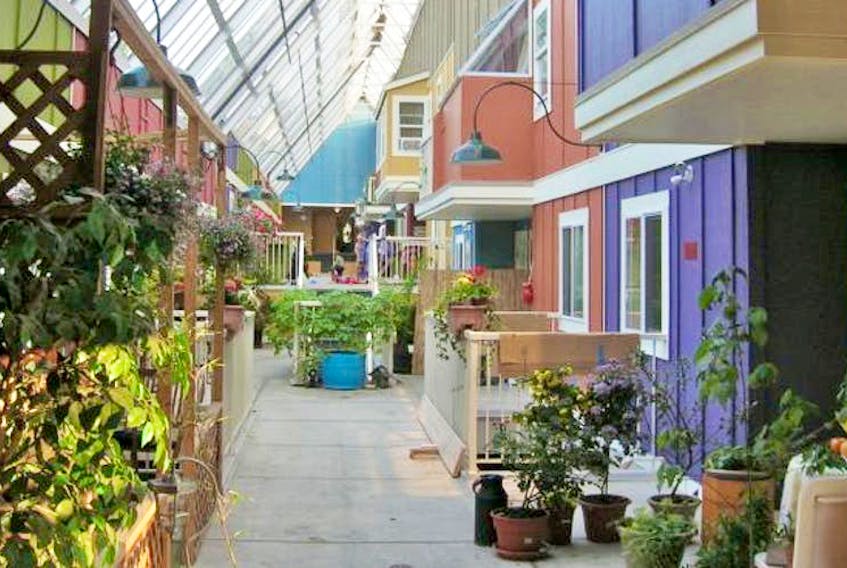One of the things that I took away from Blizzard 2020 is how Newfoundland is very suited to and more than ready for co-housing.
Co-housing is not the same as co-living nor is it a throw-back to communes.

Wikipedia describes co-housing as “an intentional community of private homes clustered around shared space. The term originated in Denmark in late 1960s.
Each attached or single-family home has traditional amenities, including a private kitchen. Shared spaces typically feature a common house, which may include a large kitchen and dining area, laundry and recreational spaces.
Shared outdoor space may include parking, walkways, open space and gardens. Neighbours also share resources like tools and lawnmowers.”
As you can see from “may include,” none of these attributes are carved in stone. I say we are well suited to this type of housing because we already understand and appreciate the principles behind this design — community and sharing.
There’s no one in my generation who grew up in Newfoundland and didn’t know their neighbours. But things change. In a co-housing model that tradition could not only be carried on but enhanced in many ways. It wouldn’t take a storm of massive proportions to get to know your neighbours, although that’s the silver lining in a storm cloud.
The design of co-housing communities emphasizes connection with neighbours. Kitchens facing into a courtyard keep people in touch with who’s around and what’s happening. People feel safer because they are safer with one of the neighbours guaranteed to notice something amiss.
Some homeowners share vacuums, tools or carpooling. Good neighbours help out in emergencies and share good times, which is the whole idea of co-housing, and why we’re already a step ahead in living the concept.
Another advantage is when co-housing provides rooms that the homeowner might only use once or twice a year, like a guest room or party room.
One community I read about has 34 town homes in two rows facing each other across a pedestrian street which is covered by a greenhouse-style glass roof enabling residents to get outdoors in all kinds of weather.

Be still my heart. OK, that community is in B.C. where they’re more concerned about rain than snowstorms, but glass roof or not, this kind of living appeals to me much more so than any of the alternatives currently available to seniors wanting to downsize.
But co-housing doesn’t have to be just for seniors. Just because you’re a senior doesn’t mean you want to be (or should be) surrounded exclusively by seniors. Children benefit from having older people in their lives and older people enjoy children (as long as they belong to someone else, haha).
Co-housing neighbourhoods can be home to families, couples, seniors and singles, anyone really who appreciates the benefits of knowing their neighbours; the interacting and helping each other out. In co-housing, seniors who are still living independently but feel isolated and families who want their kids to know the freedom of playing outdoors independently and safely are as close to the advantages of outport living as a townie can get.
We have 55-plus neighbourhoods here. Wouldn’t having the backs of the houses on the street and the fronts on a central space of some sort make them more neighbourly?
Locally, there is a co-housing movement underway in Portugal Cove–St. Philips spearheaded admirably by Wendy Reid Fairhurst, a private citizen. It seems to me that with a focused approach to co-housing, Newfoundland and Labrador could become the model for others to follow.
Sure, we’re naturals for it. Of course, for that very reason you could argue that we don’t really need it. Well we do. And we need it to be affordable.
We have 55-plus neighbourhoods here. Wouldn’t having the backs of the houses on the street and the fronts on a central space of some sort make them more neighbourly?
Canada Mortgage and Housing Corp. has a seed funding program that grants financial assistance to carry out the initial activities required to develop a proposal for an affordable housing project. Co-housing developments are not all in the affordable housing range, but many are.
If you’re interested check out ‘An Affordable Conference for Affordable Co-housing’ taking place online Feb. 22.
Janice Wells lives in St. John’s. She can be reached at [email protected]. (or [email protected].)
MORE FROM JANICE WELLS:









